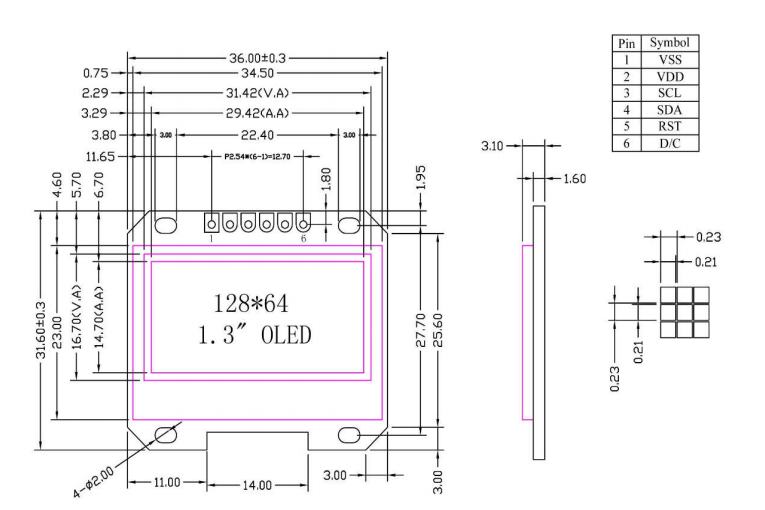Please kindly contact us for full data sheet of the display.
HICENDA The 1.3-inch OLED display module, model HT130C, is a high-performance passive matrix display designed for compact embedded applications. With a resolution of 128×64 dots, this module employs either the SSD1306 or SH1106 driver IC, communicating via the SPI interface. The module features a monochrome output in white or blue, a 6-pin configuration, and supports a wide operating temperature range from -20°C to +70°C. Its precise pixel pitch of 0.23 mm and IPS viewing orientation contribute to excellent display clarity across angles, making it suitable for wearables, portable electronics, and industrial instrumentation.
.
GENERAL SPECIFICATION
OLED (Organic Light Emitting Diode) panels emit light individually from each pixel, requiring no backlight and offering high contrast, rapid response, and superior viewing angles. The HT130C utilizes a passive matrix structure driven at a 1/64 duty cycle, allowing for power-efficient performance while preserving brightness and visibility.
Engineered for embedded environments, the module maintains a slim profile (3.1 mm thick) while offering a generous active display area of 31.42 mm × 16.7 mm. Its IPS-like display alignment ensures stable contrast and color reproduction from a wide range of viewing directions, supporting user-centric applications.
The SPI (Serial Peripheral Interface) is preferred in embedded systems for its speed and simplicity. The 1.3-inch OLED module supports standard SPI signaling with a 6-pin connection, facilitating quick integration with microcontrollers like Arduino, STM32, or ESP32.
The SSD1306 and SH1106 are two widely used display controllers for OLED modules. While both support 128×64 resolutions, the SH1106 features a 132×64 internal buffer, offering slightly different memory addressing. Developers should verify compatibility within firmware libraries such as U8g2 or Adafruit SSD1306.
This module is widely adopted in environments requiring compact graphical output and low-power operation, including:
Wearable electronics and health monitors
Industrial control terminals
Battery-powered IoT devices
DIY projects and development platforms
To ensure optimal performance, designers should:
Ensure stable voltage supply (commonly 3.3V or 5V with level shifting)
Observe SPI timing constraints for clean signal transmission
Choose compatible libraries that distinguish between SSD1306 and SH1106 memory mapping
Provide adequate decoupling capacitors near the power supply input
Specification
Details
Model No.
HT130C
Display Size
1.3 inch
Resolution
128×64 dots
Display Type
Passive Matrix OLED
Viewing Direction
IPS
Display Format
128×64 dots
Outline Dimensions
36.0 mm × 31.6 mm × 3.1 mm
Active Area
31.42 mm × 16.7 mm
Effective Area
29.42 mm × 14.7 mm
Pixel Size
0.21 mm × 0.21 mm
Pixel Pitch
0.23 mm × 0.23 mm
Driver IC
SSD1306 / SH1106
Display Color
Monochrome (White / Blue)
Drive Duty
1/64 Duty
Interface
SPI
Display Mode
Passive Matrix
Pin Count
6 Pins
Operating Temperature
-20°C to +70°C
Storage Temperature
-30°C to +80°C
Structural and Display Characteristics
OLED Technology Fundamentals
Physical Dimensions and Viewing Attributes
Interface and Driver IC Considerations
SPI Communication Protocol
SSD1306 vs SH1106 Drivers
Applications and Implementation
Practical Use Cases
Integration Advice


In conclusion, the HT130C 1.3-inch OLED module is a well-balanced solution combining display clarity, hardware simplicity, and environmental reliability. Its straightforward SPI interface, paired with established controller ICs and mature firmware support, makes it a versatile and future-proof choice for engineers, makers, and system integrators. Whether you're crafting a commercial product or a personal project, this module offers a compact yet robust visual output that scales across industries and innovations.
Contact: David
Phone: +8618665976986
Tel: +8675521563288
Email: [email protected]
Add: 305 Room A Buiding Huafeng International Robot Industrial Park Xixiang Bao'an